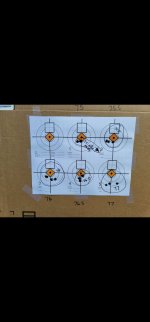Hi everyone! I am fairly new to reloading and was hoping to get some advice from some of you that have been doing it for awhile! I am getting ready to start load development for my 300WM with Berger 205’s, CCI250 primers, H1000, and Norma Brass and was hoping to get some tips on where to start. For load development, I can only shoot out to 150 yards – but I do have access to a range out to 500 yards, but it is a hike from my house and prefer to get the majority of it done at 100 yards and fine tune at the longer distances.
With that being said, how does everyone start load development? I was thinking of starting about 2-3gr lower than Berger’s max load data and performing a pressure test in .5gr increments at .010 off all while looking for similar vertical points of impact. If I get a few consecutive similar points, to select the middle of them and perform seating depth testing at 10, 20, 30, and 40 off. Once I find the seating depth node, go back and fine tune the powder charge. My question with this being, how reliable are the vertical impacts on the pressure test if my rifle hates to shoot this bullet at 10 off (don’t know if it does, just wondering)? What does everyone usually do here? What do you do if during the pressure test none of the vertical points of impact are really that close?
Has anyone ever tried the Berger recommended load development method of starting with the minimum charge listed in the manual and seat the bullets at 10, 50, 90, and 130 off? I feel like the minimum charge is way too low and the jumps of seating depth are way too large. I know for the 205's for example the minimum load is 70.9 and the maximum load is 77.9 - so if I do seating depth at 70.9 and say it likes .050, and I bump the powder charge up to 76 gr, would that not dramatically change the pressure and likely change that seating depth node? So, it all seems counterintuitive lol.
I appreciate any feedback/advice!
With that being said, how does everyone start load development? I was thinking of starting about 2-3gr lower than Berger’s max load data and performing a pressure test in .5gr increments at .010 off all while looking for similar vertical points of impact. If I get a few consecutive similar points, to select the middle of them and perform seating depth testing at 10, 20, 30, and 40 off. Once I find the seating depth node, go back and fine tune the powder charge. My question with this being, how reliable are the vertical impacts on the pressure test if my rifle hates to shoot this bullet at 10 off (don’t know if it does, just wondering)? What does everyone usually do here? What do you do if during the pressure test none of the vertical points of impact are really that close?
Has anyone ever tried the Berger recommended load development method of starting with the minimum charge listed in the manual and seat the bullets at 10, 50, 90, and 130 off? I feel like the minimum charge is way too low and the jumps of seating depth are way too large. I know for the 205's for example the minimum load is 70.9 and the maximum load is 77.9 - so if I do seating depth at 70.9 and say it likes .050, and I bump the powder charge up to 76 gr, would that not dramatically change the pressure and likely change that seating depth node? So, it all seems counterintuitive lol.
I appreciate any feedback/advice!


